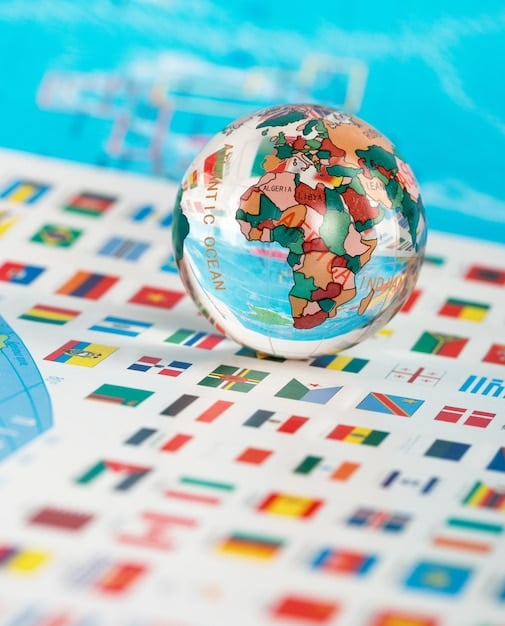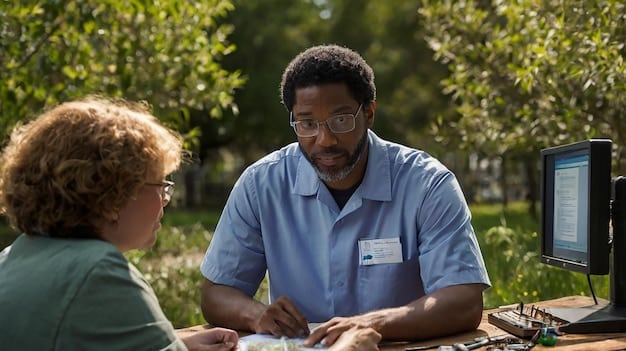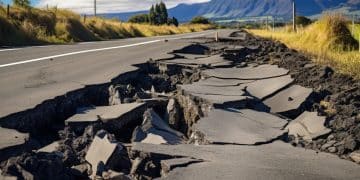UN Sustainable Development Goals: US Relief Efforts in 2025

UN Sustainable Development Goals and US Relief Efforts: A 2025 Progress Report examines America’s contributions to global sustainability goals, highlighting both achievements and challenges in areas such as poverty reduction, environmental protection, and international cooperation.
The UN Sustainable Development Goals and US Relief Efforts: A 2025 Progress Report provides a comprehensive analysis of the United States’ commitment to achieving the UN’s ambitious goals, shedding light on the nation’s progress, setbacks, and future strategies.
Un Sustainable Development Goals: An Overview
The UN Sustainable Development Goals (SDGs) are a universal call to action to end poverty, protect the planet, and ensure that all people enjoy peace and prosperity by 2030. Adopted by all United Nations Member States in 2015, the SDGs represent a comprehensive framework for global development.
The Core Objectives of the SDGs
These goals cover a broad range of issues, from reducing inequality to promoting sustainable consumption and production. They are designed to be interconnected, recognizing that action in one area will affect outcomes in others.
- End poverty in all its forms everywhere.
- Ensure healthy lives and promote well-being for all at all ages.
- Ensure inclusive and equitable quality education and promote lifelong learning opportunities for all.
- Take urgent action to combat climate change and its impacts.
The SDGs provide a roadmap for governments, businesses, and individuals to work together to create a more sustainable and equitable world. Achieving these goals requires coordinated efforts and a shared commitment to addressing global challenges.

Us Commitment to the Sustainable Development Goals
The United States has played a significant role in shaping and implementing the UN Sustainable Development Goals. Through various initiatives and policies, the US has demonstrated its commitment to addressing global challenges and supporting sustainable development efforts worldwide.
Us Foreign Aid and Development Assistance
The US provides substantial financial and technical assistance to developing countries, focusing on areas such as health, education, and economic growth. These investments are critical for achieving the SDGs in many parts of the world.
US foreign aid supports numerous programs aimed at improving living conditions and building sustainable communities. These efforts are aligned with the SDGs and contribute to measurable progress in key areas.
Private Sector Involvement
American businesses are increasingly recognizing the importance of the SDGs and are integrating sustainability into their operations. This includes investing in clean energy, promoting responsible supply chains, and supporting community development projects.
The private sector’s engagement is essential for achieving the SDGs, as businesses have the resources and innovation to drive significant change. Many US companies are now reporting on their contributions to the SDGs and setting ambitious sustainability targets.
In conclusion, the US commitment to the Sustainable Development Goals is multifaceted, involving government initiatives, private sector engagement, and civil society organizations. This collaborative approach is essential for addressing the complex challenges of sustainable development.
Progress in Poverty Reduction and Health
Two critical areas within the SDGs are poverty reduction and ensuring healthy lives. The US has made notable contributions to these goals, both domestically and internationally, although challenges remain.
Reducing Poverty in the Us and Abroad
The US has implemented various programs to reduce poverty within its borders, including social safety nets and job training initiatives. Globally, US aid supports poverty reduction programs in developing countries, focusing on economic empowerment and access to essential services.
These efforts have yielded positive results, but poverty remains a persistent issue. The US continues to explore innovative approaches to address the root causes of poverty and create opportunities for all.
For instance, programs that provide microloans to entrepreneurs in developing countries have proven effective in lifting families out of poverty. Similarly, domestic initiatives that support education and job training can help individuals escape the cycle of poverty.
Improving Health Outcomes Globally
The US is a major contributor to global health initiatives, supporting programs that combat infectious diseases, improve maternal and child health, and strengthen healthcare systems in developing countries. These efforts have had a significant impact on reducing mortality rates and improving overall health outcomes.
For example, US-funded programs have played a key role in the fight against HIV/AIDS, malaria, and tuberculosis. These programs provide essential resources, including medication, training, and infrastructure, to help countries control and eliminate these diseases.

Environmental Protection and Climate Action
Addressing environmental issues and combating climate change are central to the SDGs. The US has undertaken various initiatives to protect the environment and mitigate the impacts of climate change, although its commitment has varied over time.
Us Policies on Climate Change
The US has implemented policies to reduce greenhouse gas emissions, promote renewable energy, and improve energy efficiency. These policies aim to transition the country to a low-carbon economy and contribute to global efforts to combat climate change.
- Investing in renewable energy sources such as solar and wind power.
- Implementing energy efficiency standards for buildings and appliances.
- Supporting international agreements to reduce greenhouse gas emissions.
While the US has made progress in reducing its carbon footprint, challenges remain. Further action is needed to meet the ambitious targets set by the Paris Agreement and to fully transition to a sustainable energy system.
Protecting Biodiversity and Natural Resources
The US has established national parks, protected areas, and conservation programs to preserve biodiversity and protect natural resources. These efforts aim to safeguard ecosystems, prevent deforestation, and ensure the sustainable use of natural resources.
These initiatives are crucial for maintaining the health of the planet and supporting the livelihoods of communities that depend on natural resources. Protecting biodiversity is essential for ensuring the long-term sustainability of ecosystems and the services they provide.
In summary, the US has taken significant steps to protect the environment and combat climate change, but continued efforts are needed to achieve the SDGs and ensure a sustainable future for all.
Challenges and Opportunities for the Us
Despite the progress made, the US faces several challenges in achieving the Sustainable Development Goals. Addressing these challenges requires innovative solutions and a renewed commitment to sustainable development.
Addressing Inequality and Social Justice
Inequality remains a persistent issue in the US, with significant disparities in income, education, and access to opportunities. Addressing inequality and promoting social justice are essential for achieving the SDGs and ensuring that all people can participate fully in society.
Poverty and inequality disproportionately affect marginalized communities, including racial and ethnic minorities, women, and people with disabilities. Targeted interventions are needed to address these disparities and create a more equitable society.
Strengthening International Cooperation
Achieving the SDGs requires strong international cooperation and a shared commitment to addressing global challenges. The US can play a leading role in fostering collaboration and supporting sustainable development efforts worldwide.
This includes providing financial and technical assistance to developing countries, participating in international agreements, and working with other nations to address shared challenges such as climate change and pandemics.
In conclusion, while the US has made progress towards achieving the Sustainable Development Goals, significant challenges remain. Addressing these challenges requires a renewed commitment to sustainable development, innovative solutions, and strong international cooperation.
Future Directions and Recommendations
To accelerate progress towards the Sustainable Development Goals, the US needs to adopt a comprehensive and integrated approach that addresses the interconnected nature of the SDGs. This requires bold leadership, innovative policies, and strong partnerships.
Investing in Sustainable Infrastructure
Investing in sustainable infrastructure is crucial for achieving the SDGs and building a resilient economy. This includes investing in renewable energy, energy-efficient buildings, sustainable transportation, and resilient water systems.
These investments can create jobs, stimulate economic growth, and reduce greenhouse gas emissions. They can also improve the quality of life for communities and enhance their resilience to climate change and other environmental challenges.
- Promoting the development of smart grids and energy storage technologies.
- Investing in public transportation and electric vehicle infrastructure.
- Implementing green building standards for new construction and renovations.
Promoting Sustainable Consumption and Production
Promoting sustainable consumption and production patterns is essential for reducing environmental impacts and ensuring the sustainable use of natural resources. This includes reducing waste, promoting recycling, and encouraging businesses to adopt sustainable practices.
Consumers also have a role to play by making informed choices about the products they buy and the services they use. By supporting sustainable businesses and adopting eco-friendly habits, consumers can drive demand for more sustainable products and practices.
In summary, to fully embrace the SDGs, the US must focus on sustainable infrastructure and promote responsible consumption and production. These proactive steps are crucial for a resilient and eco-friendly future.
| Key Point | Brief Description |
|---|---|
| 🌍 Global Commitment | US efforts align with international goals for sustainability. |
| ⚕️ Health Initiatives | Focus on combating diseases and improving healthcare systems. |
| 🌱 Environmental Action | Policies to reduce emissions and protect natural resources. |
| 🤝 Collaboration | Partnerships are vital for achieving sustainable development goals. |
Frequently Asked Questions
▼
The UN Sustainable Development Goals are a collection of 17 global goals designed to be a “blueprint to achieve a better and more sustainable future for all” by 2030, addressing global challenges.
▼
The US contributes through financial aid, policy implementation, and private sector initiatives aimed at supporting health, education, sustainability, and reducing inequality both at home and abroad.
▼
Key challenges include addressing domestic inequality, ensuring continued commitment to environmental protection, and maintaining strong international cooperation despite changing political landscapes.
▼
Government agencies (USAID), non-profits (Red Cross), and private corporations are significantly involved, focusing on areas from disaster relief to long-term sustainable development projects.
▼
Official UN reports, USAID publications, and reports from organizations like the Brookings Institution offer detailed data and analyses on US contributions and progress toward achieving the SDGs.
Conclusion
In conclusion, the UN Sustainable Development Goals and US Relief Efforts: A 2025 Progress Report highlights both the significant strides and the persistent challenges in America’s pursuit of global sustainability. While considerable efforts have been made, a continued commitment to innovation, collaboration, and equitable policies is crucial to achieving a truly sustainable future.





